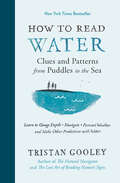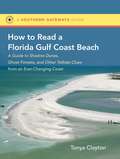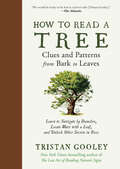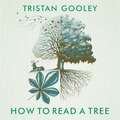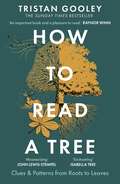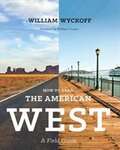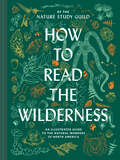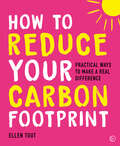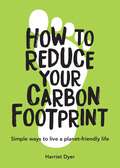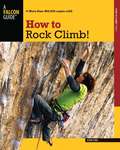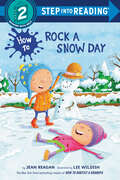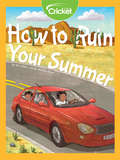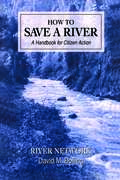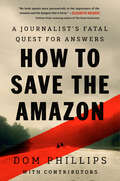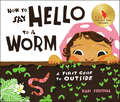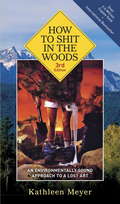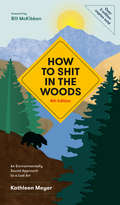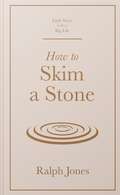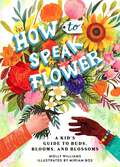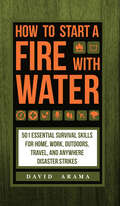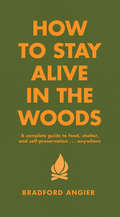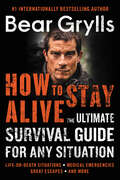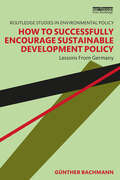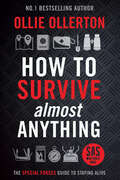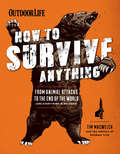- Table View
- List View
How to Read Water: Clues And Patterns From Puddles To The Sea (Natural Navigation #0)
by Tristan GooleyHone your senses and learn to read the hidden signs of nature—from master outdoorsman Tristan Gooley, New York Times-bestselling author of How to Read a Tree and The Lost Art of Reading Nature’s Signs “Equal parts alfresco inspiration, interesting factoids, how-to instructions and self-help advice.”—The Wall Street Journal When most of us go for a walk, a single sense—sight—tends to dominate our experience. But when New York Times–bestselling author and expert navigator Tristan Gooley goes for a walk, he uses all five senses to “read” everything nature has to offer. A single lowly weed can serve as his compass, calendar, clock, and even pharmacist. In How to Read Nature, Gooley introduces readers to his world—where the sky, sea, and land teem with marvels. Plus, he shares 15 exercises to sharpen all of your senses. Soon you’ll be making your own discoveries, every time you step outside!
How to Read a Florida Gulf Coast Beach
by Tonya ClaytonCome explore the geology of Florida's Gulf Coast beaches, from a bird's-eye view down to a crab's-eye view. You'll journey from Panhandle sugar-sand beaches to southwestern shell beaches, taking a fresh look at the ever-changing landscape. With Tonya Clayton as your guide, you'll learn how to recognize the stories and read the clues of these dynamic shores, reshaped daily by winds, waves, and sometimes bulldozers or dump trucks.This dynamic tour begins with a broad description of Florida's Gulf Coast, roaming from popular Perdido Key in the northwest to remote Cape Sable in the south. You'll first fly over large-scale coastal features such as the barrier islands, learning to spot signs of the many processes that shape the shores. In subsequent chapters you'll visit dunes and beaches to check out sand ripples, tracings, and other markings that show the handiwork of beach breezes, ocean waves, animal life, and even raindrops and air bubbles. You'll also encounter signs of human shaping, including massive boulder structures and sand megatransfers. With a conversational style and more than a hundred illustrations, How to Read a Florida Gulf Coast Beach makes coastal science accessible, carrying vacationers and Florida natives alike on a lively, informative tour of local beach features.Southern Gateways Guide is a registered trademark of the University of North Carolina Press
How to Read a Tree: Clues And Patterns From Bark To Leaves (Natural Navigation #0)
by Tristan Gooley“Reams of appealing facts make one itch to get outside and right up close to trees’ rough surfaces and shady cover.”—The Atlantic New York Times–bestselling author Tristan Gooley opens our eyes to the secret language of trees—and the natural wonders they reveal all around us Trees are keen to tell us so much. They’ll tell us about the land, the water, the people, the animals, the weather, and time. And they will tell us about their lives, the good bits and bad. Trees tell a story, but only to those who know how to read it. In How to Read a Tree, Gooley uncovers the clues hiding in plain sight: in a tree’s branches and leaves; its bark, buds, and flowers; even its stump. Leaves with a pale, central streak mean that water is nearby. Young, low-growing branches show that a tree is struggling. And reddish or purple bark signals new growth. Like snowflakes, no two trees are exactly the same. Every difference reveals the epic story this tree has lived—if we stop to look closely.
How to Read a Tree: The Sunday Times Bestseller
by Tristan GooleyDo two trees ever appear identical? No, but why? Every small difference is a clue.Each tree we meet is filled with signs that reveal secrets about the life of that tree and the landscape we stand in. The clues are easy to spot when you know what to look for, but remain invisible to most people.In How to Read a Tree, you'll discover the simple principles that explain the shapes and patterns you can see in trees and what they mean. And you'll learn rare skills that can be applied every time you pass a tree, whether you are in a town or a wilder spot.As the author of the international bestsellers The Walker's Guide and How to Read Water, Tristan Gooley knows how to uncover the phenomena worth looking for. He has been instructing people in the art of reading trees for two decades and this book includes signs that will not be found in any other book in the world.Once you have learned to see these things it is impossible to unsee them. We will never look at a tree the same way again.(P) 2023 Hodder & Stoughton Limited
How to Read a Tree: The Sunday Times Bestseller
by Tristan Gooley'An important book and a pleasure to read.' - Raynor Winn, author of The Salt Path'You will never look at a tree in the same way again after reading this mesmerising book. Gooley drops learning as lightly as blossom falls in spring.' - John Lewis-Stempel'Tristan Gooley has done trees the greatest service.' - Isabella Tree'It was a lightbulb moment! I thought I knew my local woods - I walk there almost every day. But it's a thrill to see it through fresh eyes, to develop a much deeper understanding.' - Peter Gibbs, Chair of BBC Gardeners' Question Time'Wherever you are - city or wilderness - if you want to understand the secrets of trees you pass, this is the book to read...Tristan has the rare gift of explaining the most complex ideas with humour and deep insight.' - Peter Thomas, Emeritus Reader in Plant Ecology at Keele University, author of Trees'Will undoubtedly leave you with a deeper appreciation of trees...your country walks will never be quite the same again' - Daily Mail'This book will add a new dimension to your countryside stroll.' WanderlustDo two trees ever appear identical? No, but why? Every small difference is a clue.Each tree we meet is filled with signs that reveal secrets about the life of that tree and the landscape we stand in. The clues are easy to spot when you know what to look for, but remain invisible to most people.In How to Read a Tree, you'll discover the simple principles that explain the shapes and patterns you can see in trees and what they mean. And you'll learn rare skills that can be applied every time you pass a tree, whether you are in a town or a wilder spot.As the author of the international bestsellers The Walker's Guide and How to Read Water, Tristan Gooley knows how to uncover the phenomena worth looking for. He has been instructing people in the art of reading trees for two decades and this book includes signs that will not be found in any other book in the world.Once you have learned to see these things it is impossible to unsee them. We will never look at a tree the same way again.
How to Read the American West: A Field Guide (Weyerhaeuser Environmental Books)
by William WyckoffThis innovative field guide includes stories, photographs, maps, and diagrams on a hundred landscape features across the American West. Features are grouped according to type, such as natural landscapes, farms and ranches, places of special cultural identity, and cities and suburbs. Unlike the geographic organization of a traditional guidebook, the author's field guide draws attention to the connections and the differences between and among places. Emphasizing features that recur from one part of the region to another, the guide takes readers on an exploration of the eleven western states with trips into their natural and cultural character. This book is an ideal traveling companion on the main roads and byways in the West, providing unexpected insights into the landscapes you see out your car window. It is also a wonderful source for armchair travelers and people who live in the West who want to learn more about the modern West, how it came to be, and how it may change in the years to come. Showcasing the everyday alongside the exceptional, the author demonstrates how asking new questions about the landscapes of the West can let us see our surroundings more clearly, helping us make informed and thoughtful decisions about their stewardship in the twenty-first century.
How to Read the Wilderness: An Illustrated Guide to North American Flora and Fauna
by Nature Study GuildThis book invites you to see the natural world in all its intricacy and intense beauty and become a knowledgeable steward of the wild.From the mountains to the ocean shores, from the wetlands to the deserts, North America teems with flora and fauna in delicately balanced ecosystems found nowhere else on Earth. With this book in hand, you will understand the language of nature and see those wild places with new eyes. You'll learn to recognize the lobed leaf of an Oracle Oak, the webbed tracks of a River Otter, and the fine, cream-colored tentacles of a Frilled Anemone. This volume celebrates a tradition of knowledge established by the Nature Study Guild. For more than sixty years, the Guild's pocket guidebooks have helped hikers, campers, foragers, and explorers navigate the great outdoors. Now, the best of the guides' informative text and iconic illustrations are gathered in one handsome hardcover: the perfect reference for today's ramblers.FOR NATURE LOVERS OLD AND NEW: More and more people are invested in and curious about the natural world—from avid campers and hikers to those worried about climate change. This book, with its celebratory tone and charming vintage style, will appeal to anyone who cherishes the natural world.NOSTALGIC APPEAL: The classic nature illustration style evokes memories of learning about flora and fauna in childhood, making this a wonderfully nostalgic gift.BEAUTIFUL BLEND OF ART AND SCIENCE: This volume presents detailed scientific information in a gorgeous package, a deluxe hardcover that will grace coffeetables and bookshelves. It makes a perfect gift for anyone interested in biology or illustration (or both!).Perfect for:Nature loversHikers, campers, and foragersEnvironmentalistsScientists and science studentsTeachers and parentsFans of vintage illustrationArtists
How to Reduce Your Carbon Footprint: Practical Ways to Make a Real Difference
by Ellen ToutThe ultimate guide to minimizing your impact on the environment, with hundreds of practical ways to help combat the climate crisis.Turn over a green leaf in every aspect of your life with this comprehensive guide. Packed with a wealth of information and practical, professional and up-to-date advice about making achievable and sustainable changes, this book can show you how to take a responsible approach to all aspects of your lifestyle including shopping, eating, travel, home life and work habits.The book is organized into key topics so that it is easy and intuitive to find unexpected ways to achieve change with minimal effort. For each topic, key statistics and facts help you to stay informed and understand more deeply our impact on the environment.Everywhere you look, there's a way to cut carbon without affecting your quality of life. Whether it be a simple change of habit, or a forward-thinking home improvement project, you'll find plenty of suggestions that relate to you, proving that sustainable living is good not only for the planet, and sometimes your bank balance, but also your health and your karma.
How to Reduce Your Carbon Footprint: Simple Ways to Live a Planet-Friendly Life
by Harriet DyerDo you ever feel overwhelmed by the thought of the climate emergency?Do you want an eco-friendly lifestyle but don’t know where to start?Then dive into this little book, full of simple, achievable ways to help you reduce your carbon footprint. From tips on creating a more eco-friendly home and ways to reduce your plastic use, to advice on shopping sustainably, within these pages you will discover everything you need to know to help you make planet-friendly choices and live a more sustainable life.
How to Rock Climb, (How to Climb Series)
by John LongThoroughly revised and updated to reflect the modern standards of equipment, technique, and training methods, this guide includes sections on face climbing; crack climbing; ropes, anchors, and belays; getting off the rock; sport climbing; and much more. It is the essential how-to book for rock climbers everywhere.
How to Rock a Snow Day (Step into Reading)
by Jean ReaganA snow day! That means no school...But what will we do today? From the New York Times bestselling creators of How to Babysit a Grandpa comes a seasonal Step 2 early reader packed with snow much fun!School is canceled, and there is so much to do: snow angels, lunch, sledding... Will the other kids be able to finish everything on our snow day to-do list?! Join them as they enjoy a snow-filled day of winter activities! Perfect for children who are ready to read on their own. Step 2 readers use basic vocabulary and short sentences to tell simple stories. They are perfect for children who recognize familiar words and can sound out new words with help.
How to Ruin Your Summer
by Tori TelferWhen two best friends are separated over summer break, they make a pact to have the most boring summer ever. No summer fun means no swimming at the pool, no popsicles, and no water balloons, and that’s just the start! Maybe a boring road trip will be just what Sammy needs to keep having no fun.
How to Save a River: A Handbook For Citizen Action
by David M BollingHow to Save a River presents in a concise and readable format the wisdom gained from years of river protection campaigns across the United States. The book begins by defining general principles of action, including getting organized, planning a campaign, building public support, and putting a plan into action. It then provides detailed explanations of how to: form an organization and raise money develop coalitions with other groups plan a campaign and build public support cultivate the media and other powerful allies develop credible alternatives to damaging projects How to Save a River provides an important overview of the resource issues involved in river protection, and suggests sources for further investigation. Countless examples of successful river protection campaigns prove that ordinary citizens do have the power to create change when they know how to organize themselves.
How to Save the Amazon: A journalist’s fatal quest for answers
by Dom Phillips&“A book both brilliant and broken, [and] one that is ultimately as inspiring and devastating as the Amazon itself.&”—The GuardianJournalist Dom Phillips traveled deep into the Amazon rainforest searching for solutions to the problem of deforestation, a threat to the local ecosystem, native tribes, and the global climate. When he was murdered in the Javari Valley by a group of environmental criminals, a cohort of journalists and activists took up his work to finish his book and share his important message.During the dark days of the Bolsonaro administration, British journalist Dom Phillips set out to accomplish an ambitious goal: through research, interviews, and site visits deep in the rainforest, he would emerge with a book answering the question—how can we save the Amazon? Traveling with his companion Indigenous expert Bruno Pereira, Dom&’s adventure includes trekking through Amazonia to see where ranching, fires, illegal fishing, mining, the drug trade, and urbanization have deforested and degraded millions of acres of important forest, degraded ecosystems, and created dangerous conditions for the Indigenous tribes who have called the Amazon home for thousands of years.Jair Bolsonaro came into power on a platform of anti-environmental exploitation and deregulation. During his term, deforestation in the Amazon, the &“lungs of Planet Earth,&” increased exponentially as environmental criminals took advantage of lax rules, advantageous land use policy, and the difficulty of enforcing laws in a remote area of immense size. Lawlessness reigned and environmental activists found themselves in danger. With the intention of discovering strategies to protect both the land and the people who inhabit it, Dom connected with politicians, farmers, and Indigenous activists to study the benefits and pitfalls of solutions like agroforestry, tourism, and the bioeconomy. While traveling by boat in the Javari Valley, Dom and Bruno were brutally murdered. Unwilling to see her late husband&’s work be for naught, Dom&’s widow, Ale, and his literary agent assembled a team of expert writers, journalists, and activists to complete his work, with each tackling one unfinished chapter and grappling with the challenge of interpreting his field notes and discovering his conclusions. How to Save the Amazon, therefore, is a book both by and about Dom Phillips, his quest for answers, and his search for hope.&“A work of courage interrupted by tragedy. . . No book speaks more persuasively to the importance of the Amazon and the dangers that it faces.&”—Elizabeth Kolbert, Pulitzer Prize-winning author of The Sixth Extinction"We can't let life on this earth be snuffed out; this powerful book will help us rise to this challenge."—Bill McKibben, author of The End of Nature
How to Say Hello to a Worm: A First Guide to Outside
by Kari PercivalSay "hello" to worms, dirt, peas, and more in this gentle how-to guide for connecting with nature.* Winner of the EZRA JACK KEATS WRITER AWARD* An ALA Notable Children&’s Book * A CLEL Bell Award WinnerThe beautiful simplicity of a garden is depicted through digital woodcut illustrations and engaging nonfiction text presented as a series of sweet questions and gentle replies. Less of a traditional how-to and more of a how-to-appreciate, this soothingly sparse text paints an inviting and accessible picture of what a garden offers. And with an all-child cast, the absence of an adult presence empowers readers to view the garden and its creatures through their own eyes, driven by curiosity and wonder.This delightful book embodies the magic of gardening and encourages all readers, from those who LOVE the outdoors to those with hesitation, to interact with nature at their own, comfortable pace.
How to Shit in the Woods, 3rd Edition
by Kathleen MeyerWHEN NATURE CALLS. . . After rowing hundreds of urban North Americans down whitewater rivers, Kathleen Meyer discovered that defecating in the wild without a commode is hardly an innate skill, but a complex procedure desperately in need of a protocol! This sobering revelation, and her subsequent mastery of the artform, has made How to Shit in the Woods the backcountry bible of eco-friendly outdoor elimination options since 1989. Long-embraced by the outdoor community, How to Shit in the Woods is still the go-to primer for backpackers and hikers, campers and climbers, skiers, sea kayakers, river runners, and all off-the-grid sojourners. The third edition presents the latest innovations, high-tech to low-tech, for responsible human waste disposal. Also featured: reflections on the increasing adoption of "packing-it-out," a practice designed to help protect sensitive environments; the most current safeguards against health risks associated with drinking straight from wilderness waterways; suggestions for purists who plan to leave the t.p. at home; and a wealth of recommendations for ladies who must make do without a loo. Meyer's delightfully shameless discussion of a once-shameful activity, her erudite examination of its associated vocabulary, and her unapologetic promotion of its colorful vernacular, make How to Shit in the Woods essential--and vastly entertaining--reading for anyone who has ever paused at the edge of the wilderness and pondered, "Where do I go to go?"From the Trade Paperback edition.
How to Shit in the Woods, 4th Edition: An Environmentally Sound Approach to a Lost Art
by Kathleen MeyerThe definitive guide to eco-friendly outdoor defecation--fully revised with a new introduction by renowned author and environmental activist Bill McKibben.More than thirty years since its first publication, Kathleen Meyer delivers an update to the beloved guide to relieving yourself responsibly. Meyer's delightfully shameless discussion of a once-secretive activity examines the environmental impact of too much crap (organic and otherwise) on our ever-shrinking wild outdoors. With the rising popularity of hiking and off-the-grid backpacking as well as the current climate crisis, How to Shit in the Woods provides timely techniques for keeping trails, bushes, and wild waters clean and protected when indoor plumbing is not an option. Meyer shares proper procedures in a way that is approachable and comprehensible for all audiences, from beginner to expert. The fourth edition features updates to outdoor laws and regulations, health statistics, and recommendations for equipment such as special trowels, funnels, and portable toilets. With more than three million copies sold, How to Shit in the Woods is the backcountry backpacker's bible, crucial for anyone looking to be wiser with their waste.
How to Skim a Stone (Little Ways to Live a Big Life #6)
by Ralph Jones'A modest masterpiece and a complete delight' - Derren BrownThis is the ultimate guide to skimming a stone.Stone skimming is an art and a science: a brief distraction on a country walk and an international sport with highly competitive championships.Ralph Jones covered last year's World Stone Skimming Championships and here, he investigates the physics, the strategy and the philosophy behind the urge we all experience when we come across a body of water and some nice flat stones. In this beautiful little book, you'll learn how to select the perfect stone, add just the right amount of spin, calculate the angle and measure the ideal distance to the first bounce on the water. Whether you're a rookie beginner or a seasoned pro, or somewhere in between, this delightful book will have you making ripples in no time.
How to Speak Flower: A Kid's Guide to Buds, Blooms, and Blossoms
by Molly WilliamsA beautifully illustrated guide to the history and symbolism of flowers for every plant lover. Sunflowers are symbols of friendship. Gardenias represent secrets and mystery. Irises say, I trust you. Flowers bring color and beauty to the everyday world around us, but flowers aren&’t just pretty: Throughout history, they have been used to express ideas about ourselves and the people we care about. From asters to zinnias, from baby&’s breath to forget-me-nots, learn the magical, meaningful language of flowers with this magnificent guide to floriography. The secrets of every bloom and blossom are revealed … and with personalized quizzes and handy charts, you&’ll discover your own flower power!
How to Start a Fire with Water: 501 Essential Survival Skills for Home, Work, Outdoors, Travel, and Anywhere Disaster Strikes
by David AramaLife is unpredictable—are you prepared for it?Should disaster ever strike, you'll feel prepared with this book as your guide. Inside you'll find tips and tricks for surviving unpredictable situations at home, work, outdoors, and while traveling. From natural catastrophes such as lightning strikes, wildfire, floods, earthquakes, and tornadoes to man-made dangers such as car accidents, plane crashes, and electrical fires, this book will help you take the first steps to survival—being prepared.
How to Stay Alive in the Woods: A Complete Guide to Food, Shelter and Self-Preservation Anywhere (In the Woods)
by Bradford AngierHOW TO STAY ALIVE IN THE WOODS is a practical, readable-and potentially indispensable-manual for anyone venturing into the great outdoors. Broken down into four essential sections, Sustenance, Warmth, Orientation and Safety, this enlightening guide reveals how to catch game without a gun, what plants to eat (full-color illustrations of these make identification simple), how to build a warm shelter, make clothing, protect yourself and signal for help. Detailed illustrations and expanded instructions, newly commissioned for this deluxe edition, offer crucial information at a glance, making How to Stay Alive in the Woods truly a lifesaver.
How to Stay Alive: The Ultimate Survival Guide for Any Situation
by Bear GryllsThe ultimate survival guide from Bear Grylls, former Special Forces soldier and #1 world-renowned "King of Survival" (Outside)For more than a decade, Bear Grylls has introduced TV viewers to the most dramatic wilderness survival situations, through his hit shows such as Man Vs. Wild. Now, with How to Stay Alive, Bear reveals to readers his full toolkit of survival tactics, from everyday basics like avoiding blisters to once-in-a-lifetime events like surviving a kidnapping.Opening with the most essential survival skills—assembling your survival kit, making a fire, building a shelter—and then moving on to more specific situations, such as escaping fire, dealing with harsh terrain, and handling medical emergencies, Grylls is a sure guide for any type of disaster situation. Readers will learn how to survive in a life raft, land a helicopter in an emergency, treat hypothermia and frostbite, escape from quicksand, and numerous other lifesaving tips.Richly illustrated with diagrams throughout, How to Stay Alive will be the definitive outdoor survival tome for years to come.
How to Successfully Encourage Sustainable Development Policy: Lessons from Germany (Routledge Studies in Environmental Policy)
by Günther BachmannThis book builds on the insights of Günther Bachmann, former Secretary General for the German Sustainability Council, who spent almost 20 years advising the German government on sustainability policy. The book discusses his experiences in negotiating stakeholder statements at the highest national levels. Bachmann takes the reader behind the scenes of German sustainable policy and practice, whilst also comparing Germany with other national approaches. He tells the story of political events from his insider perspective, unfolding the narrative of sustainable development goals and how activists in their respective countries could and should relate to it. Furthermore, he suggests new lines of vision through the tangle of conference fatigue and buzzwords. The book argues that environmentalists often display entrenched attitudes that too often downplay success. The rhetoric of crisis and doom, if overstretched and reduced to alarm, paralyses action and innovation. Bachmann, who on the contrary argues positively and concretely, shows unusual but significant signs of hope and confidence in action and how these can be made effective in the politics of sustainable development. This book will be of global relevance to sustainability professionals and policy makers and will advise them on how to successfully move ahead with sustainability policies.
How to Survive Almost Anything: The Special Forces Guide to Staying Alive
by Ollie PattonPrepare for Whatever Comes Your Way With This Essential Survival Bible“This book is your essential kit for every aspect of what life can throw at you…Brilliant.” ─Amazon reviewLearn How to Thrive Against All Odds with the Modern Survival Bible from Ex-UK Special Forces specialist Ollie OllertonBe the master of your survival. In How to Survive (Almost) Anything, former Special Forces soldier and bestselling author Ollie Ollerton passes on all the special skills, knowledge, and mindset he’s learned over the course of a life that has experienced some of the world's toughest conditions and most hostile situations.A lifeline in uncertain times. This modern-day survival bible empowers you to thrive, not just survive. Whether you're faced with the wild elements of nature, societal collapse, extreme weather, or urban warfare, this guide equips you with essential skills. Don't leave your survival to chance! Arm yourself with the knowledge and tools to face anything and become the master of your destiny.Inside you'll discover:Survival Techniques: Learn from an ex-UK Special Forces soldier how to fend off wildlife, survive natural disasters, and navigate man-made challengesMental Resilience: Equip yourself with the mindset to thrive, not just survive, in the face of emergencies and against all oddsPractical Guidance: Ideal for survivalists, prepping enthusiasts, or as a thoughtful dad gift or gift for a teen boy, this guide offers hands-on advice to face any crisis with confidence.If you have read books such as The Lost Art of Reading Nature’s Signs, Extreme Survival, Surviving the Wild, or The Ultimate Prepper's Survival Bible, you’ll love Ollie Ollerton’s How to Survive (Almost) Anything.
How to Survive Anything: From Animal Attacks to the End of the World (and Everything in Between) (Outdoor Life)
by Tim MacWelch The Editors of Outdoor LifeThis New York Times bestselling guide covers essential skills and strategies for surviving any catastrophe—from natural disasters to zombies attacks.How to Survive Anything covers situations ranging from the unexpected to the unthinkable, deftly balancing real-life survival know-how with wild scenarios that most likely won&’t ever happen. But, on the other hand, who would you rather have in your bunker? The guy who read up on killer robots or the one who didn&’t? The editors of Outdoor Life magazine cover everything from disaster preparedness to subsistence hunting and fishing, to which guns to use against the undead. After reading the expert advice in this manual, you&’ll be prepared for whatever this world throws at you.
